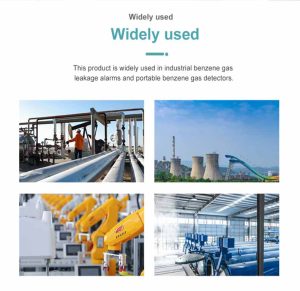Indoor air quality (IAQ) is a critical factor that directly impacts human health, comfort, and productivity. Poor IAQ can lead to various health issues, including respiratory problems, allergies, and headaches. With the majority of people spending significant time indoors, it becomes essential to monitor and improve IAQ. Gas sensors have emerged as powerful tools for monitoring indoor air pollutants, enabling effective management strategies. This article delves into the potential of gas sensors for IAQ monitoring, their benefits, and the transformative impact they can have on indoor environments.
Understanding Ind

oor Air Pollutants:
Indoor air pollutants arise from a variety of sources, including building materials, furniture, cleaning products, and human activities. Common pollutants include volatile organic compounds (VOCs), carbon dioxide (CO2), carbon monoxide (CO), nitrogen dioxide (NO2), and particulate matter. Monitoring these pollutants is crucial to identify potential sources, assess exposure risks, and implement appropriate mitigation measures.
Gas Sensors: A Key Tool for IAQ Monitoring:
Gas sensors are devices designed to detect and measure specific gases in the air. They provide real-time data on pollutant concentrations, enabling continuous IAQ monitoring. Gas sensors come in various types, including electrochemical sensors, metal oxide sensors, and photoionization detectors. Each type has its strengths and limitations, making it crucial to choose the most suitable sensor for the specific IAQ monitoring needs.
Detecting Volatile Organic Compounds (VOCs):
VOCs are a significant contributor to poor IAQ, released by various sources such as paints, adhesives, cleaning agents, and furnishings. Gas sensors equipped with VOC detection capabilities can measure the concentration levels of these harmful compounds. Real-time monitoring alerts occupants to potential sources and allows for prompt actions, such as improving ventilation or removing pollutant-emitting materials.
Monitoring Carbon Dioxide (CO2) Levels:
High levels of CO2 can indicate inadequate ventilation, which can lead to discomfort and reduced cognitive function. Gas sensors that measure CO2 levels in indoor environments provide valuable information on ventilation effectiveness. By monitoring and controlling CO2 levels, building occupants can ensure proper air exchange, leading to improved IAQ and enhanced well-being.
Carbon Monoxide (CO) Detection:
Carbon monoxide is a colorless, odorless gas that can be lethal at high concentrations. It can originate from faulty combustion appliances, such as gas stoves, fireplaces, and boilers. Gas sensors designed to detect CO can provide early warnings in the presence of this dangerous gas, allowing immediate evacuation and appropriate measures to prevent carbon monoxide poisoning.
Nitrogen Dioxide (NO2) Monitoring:
NO2 is a common indoor air pollutant produced by gas appliances, tobacco smoke, and vehicle emissions. Prolonged exposure to NO2 can cause respiratory problems and contribute to the development of asthma. Gas sensors capable of detecting NO2 enable the identification of pollution sources and the implementation of measures to reduce exposure risks.
Particulate Matter (PM) Monitoring:
Particulate matter refers to microscopic particles suspended in the air, including dust, pollen, and combustion byproducts. Fine particulate matter (PM2.5) can penetrate deep into the respiratory system, causing respiratory and cardiovascular issues. Gas sensors equipped with particulate matter detection capabilities provide real-time information on PM levels, allowing prompt actions to mitigate exposure risks.
Benefits of Gas Sensor-based IAQ Monitoring:
Gas sensors offer numerous benefits for IAQ monitoring. Firstly, they provide real-time data, allowing for immediate responses to changing IAQ conditions. Secondly, they enable targeted interventions by identifying specific pollutants and their sources. Thirdly, continuous monitoring helps assess the effectiveness of mitigation strategies and ensures long-term IAQ improvement. Lastly, data from gas sensors can be utilized for trend analysis, enabling proactive measures to maintain optimal IAQ.
Integration with Smart Building Systems:
Gas sensors can be integrated into smart building systems for enhanced IAQ management. By connecting gas sensors with building automation systems, real-time data can trigger ventilation adjustments, air purifier activation, or alerts to building occupants. This integration optimizes energy efficiency while maintaining healthy IAQ levels.
Challenges and Future Directions:
Although gas sensors offer great potential for IAQ monitoring, challenges remain. Calibration, sensor drift, and cross-sensitivity issues need to be addressed to ensure accurate and reliable measurements. Furthermore, affordability and accessibility of sensors should be improved to encourage widespread adoption. Continued research and development efforts
 : +86 155 8830 2704
: +86 155 8830 2704 : jxdziot@gmail.com
: jxdziot@gmail.com
